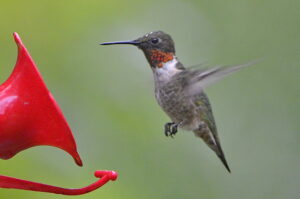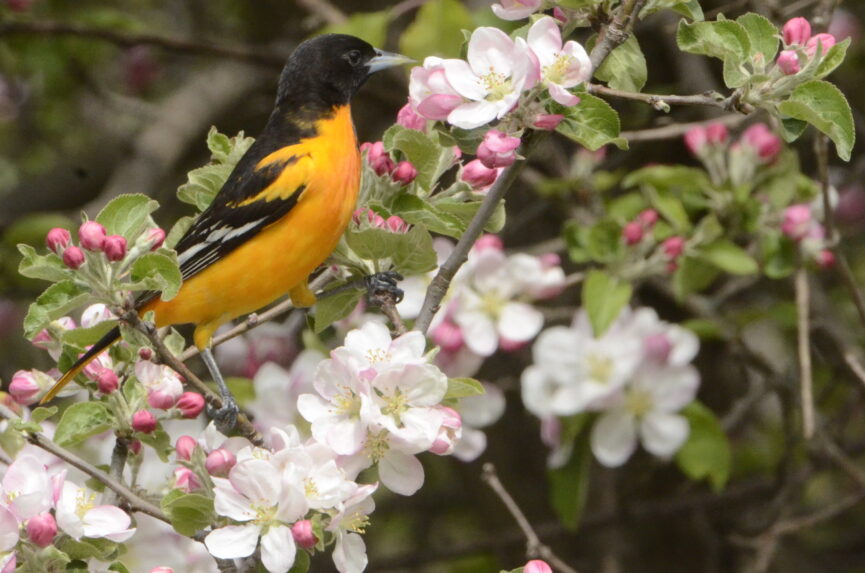The robin seems to get all the glory of being the key harbinger of spring in Michigan, and in some ways that is true. However, not all robins migrate south in the fall, with some of them wintering through, where habitat will allow, such as river bottoms. I often hear folks believing we are going to have an early spring when they have sighted robins in January and February, but I am sure they have had an occasional sighting of winter holdouts. I put more faith in seeing male redwing blackbirds, which normally show up in our neck of the woods to stake out their territories sometime in March, but that doesn’t necessarily mean spring is about to happen. It is when I finally see female redwing blackbirds begin arriving, usually 3 to 4 weeks later, that I get excited, because they seem to have a better grasp of Michigan’s fickle spring weather.
A pair of songbirds I truly look forward to each spring are the Baltimore oriole and hummingbird, which usually arrive here in late April or early May, but that timeframe can vary one way or the other, a week or two. Mid-April is when we usually put out our “nectar” oriole/hummingbird feeders, if matters aren’t freezing at night, in the event of greeting any early arrivals, which sure can happen if you aren’t ready.
Baltimore orioles get their name due to the males’ flashy flaming orange and black coloration which resembled the Coat of Arms for Lord Baltimore, who was the governor of the Maryland Colony in the 1600’s. The Baltimore oriole would later become Maryland’s state bird and even has a professional baseball team named in its honor.
The striking colors of male Baltimore orioles cause them to be easily identified and they have a very distinguishable song which I believe is one of the prettiest in the bird world. Although the females are drabber in color, they are truly beautiful too and easily identified by their hints of orange and yellow intermixed with olive green.

Ruby-throated Hummingbird
Unlike the carefree male ruby-throated hummingbird, the male Baltimore oriole is monogamous and helps the female in caring for the young. The female constructs a pouch-like nest which hangs off the end of a branch, usually quite high up in the tree, and she will lay an average of four bluish gray eggs. The young are fed by both parents through regurgitation. Besides eating nectar, the adults also eat fruit and a wide variety of insects and particularly enjoy dining on tent caterpillars, which we appreciate regarding our orchard.
Although I’ve never seen orioles eating very much of the regular seed-filled bird feeders, they certainly appreciate the suet cakes we put out and of course the nectar feeders we keep filled for both hummingbirds and orioles. We also put out orange halves on a cedar-rail fence in front of our house where the orioles will devour the fruit from in short order. We then fill the hollowed-out orange rind with grape jelly which is also quickly savored by the hungry birds, and we’ve discovered yellow-bellied sapsuckers enjoy this fare as well.
Another summertime visitor to our yard is the smaller orchard oriole, which the male is not as big or brightly colored as its Baltimore cousin. I saw the first male several summers ago, and then realized they were obviously nesting in our yard when I finally identified the very beautiful olive and yellow female which had me thumbing through the pages of my bird book to figure matters out. The male orchard oriole has a black back and head and russet breast which is very similar in color to the breast of a robin. They apparently eat everything all orioles eat and are now frequently observed at our nectar feeders.
I saw my first actual Baltimore oriole nest several years ago, after the limb it was attached to had broken off a tree in our yard. It had been newly constructed and not used yet for any eggs, which I believed was a real shame in regards to the female oriole that had laboriously woven everything together, just to have a strong wind come along and ruin it all. The nest was made of silky-like plant material and even had orange plastic twine from one of my hay bales obviously left hanging on a fence post woven throughout it, and it was quite beautiful.
The orioles generally arrive at our yard during the spring, usually right after the male hummingbirds get here to stake out territories and then leave south typically near the end of August, usually migrating to Central America, well before the hummingbirds depart. One minute there are orioles all about, and suddenly they are gone, which is their way. For whatever the reason, I’ve seen them disappear even near the end of July or early August, as birds seem to have an uncanny instinct for when to migrate.
It is clear the first pair of Baltimore orioles we ever saw in our yard more than a couple decades ago when our young trees in the yard finally became big enough for them, liked what they found and decided to return annually and bring along family and friends. I don’t know exactly how many breeding pairs we have here now, but it’s a bunch, not to mention we have orchard orioles as well.
When flowers are blooming, including lilacs, and the fruit orchard near our house is in an explosion of blossoms, and honeybees are buzzing everywhere (a beekeeper has beehives on our farm which certainly works for us) and a wide variety of songbirds are all around our yard, we have quite a feathered orchestra to listen to daily. The orioles and hummingbirds certainly add a colorful flavor to the whole mix. As always, we can’t wait for this to happen each spring!
It has taken my wife Ginny and I quite a while to constructively develop our yard to what it has become today, but it has certainly been worth the effort, and the anticipatory wait.
We are sure there are plenty of songbirds which will agree, and it is a simple case of mutual enjoyment.
- Fickle weather during December deer hunting adventures - December 3, 2025
- Michigan’s most popular opening day – November 15th - November 23, 2025
- A missing dog found while anticipating opening day - November 23, 2025

